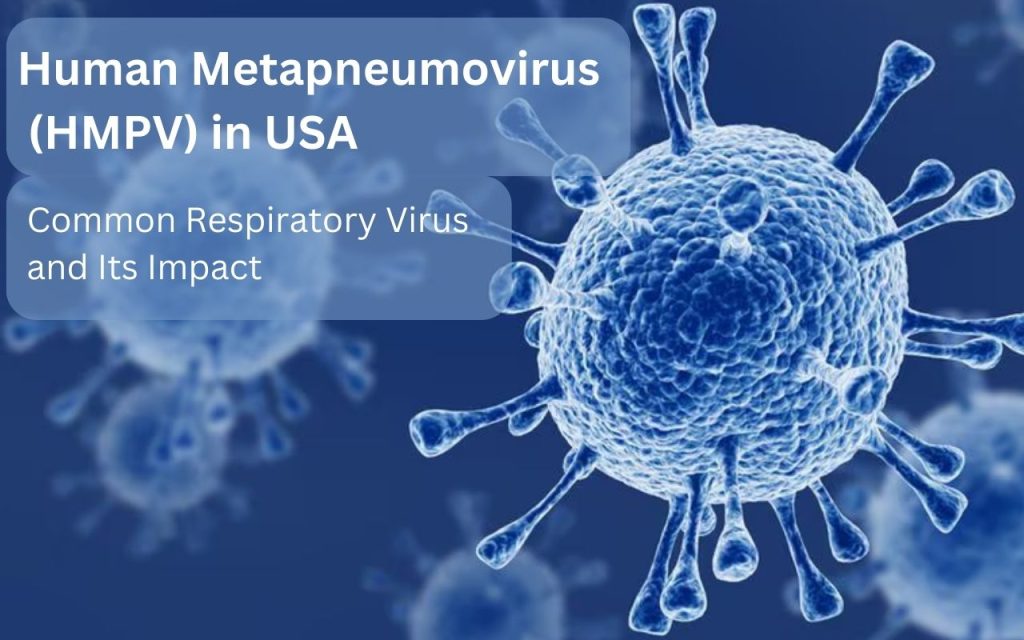Human metapneumovirus (HMPV) is a common respiratory virus that circulates USA and as well as globally, causing infections primarily during the late winter and early spring months. While it may not be as widely known as influenza or RSV, HMPV is a significant cause of respiratory illness across all age groups, from infants to the elderly. This article delves into the details of HMPV, exploring its symptoms, transmission, risk factors, treatment, and current status in the United States.
What is Human Metapneumovirus?
HMPV is a single-stranded RNA virus belonging to the Paramyxoviridae family, the same family that includes respiratory syncytial virus (RSV) and parainfluenza viruses. It was first identified in 2001 in the Netherlands, although retrospective studies suggest it has been circulating in human populations for decades.
How HMPV Spreads: Transmission and Contagion
HMPV spreads primarily through respiratory droplets produced when an infected person coughs or sneezes. These droplets can land in the mouths or noses of people who are nearby or possibly be inhaled into their lungs. Transmission can also occur through touching contaminated surfaces and then touching the face (eyes, nose, or mouth).
The virus is highly contagious, and outbreaks are common in crowded settings such as daycare centers, schools, and nursing homes. The incubation period (the time between exposure and the onset of symptoms) is typically 3 to 6 days. Infected individuals can be contagious for several days, even before symptoms appear.
Symptoms of HMPV Infection: From Mild to Severe
HMPV infection can manifest in a range of symptoms, varying in severity depending on the individual’s age and overall health.
- Mild Symptoms (Most Common):
- Cough (often a persistent cough)
- Runny nose or nasal congestion
- Sore throat
- Fever (usually low-grade)
- Headache
- Muscle aches
More Severe Symptoms (More Common in High-Risk Groups):
- Wheezing
- Shortness of breath or difficulty breathing
- Bronchitis (inflammation of the airways)
- Pneumonia (lung infection)
- Croup (a respiratory infection that causes a barking cough)
Who is at Risk for Severe HMPV Infection?
Certain groups of people are at a higher risk of developing severe HMPV infection:
- Infants and Young Children: Young children, especially those under 5 years old, are particularly susceptible to severe HMPV infection due to their immature immune systems.
- Older Adults (65+): The immune system weakens with age, making older adults more vulnerable to complications from HMPV.
- Immunocompromised Individuals: People with weakened immune systems due to conditions like HIV/AIDS, cancer, or organ transplantation are at increased risk.
- Individuals with Underlying Heart or Lung Conditions: People with pre-existing conditions such as chronic obstructive pulmonary disease (COPD), asthma, or heart disease are more likely to experience severe illness.
Diagnosis and Treatment of Human Metapneumovirus
Human Metapneumovirus infection is typically diagnosed through a nasal swab or throat swab, which is then tested using a molecular diagnostic test (such as PCR). However, because the symptoms are so similar to other respiratory viruses, it is not always specifically tested for.
There is no specific antiviral medication currently available to treat Human Metapneumovirus. Treatment focuses on supportive care to alleviate symptoms:
- Fever and Pain Management: Over-the-counter pain relievers like acetaminophen (Tylenol) or ibuprofen (Advil, Motrin) can help reduce fever and muscle aches.
- Hydration: Drinking plenty of fluids is crucial to prevent dehydration, especially in young children and older adults.
- Rest: Getting adequate rest allows the body to focus on fighting the infection.
- Oxygen Therapy and Respiratory Support: In severe cases, hospitalization may be necessary for oxygen therapy, bronchodilators (medications that open the airways), or mechanical ventilation.
Prevention Strategies: Limiting the Spread
Preventing the spread of HMPV relies on practicing good hygiene and taking precautions:
- Frequent Handwashing: Washing hands frequently with soap and water for at least 20 seconds is essential.
- Respiratory Etiquette: Covering coughs and sneezes with a tissue or the elbow helps prevent the spread of droplets.
- Avoiding Close Contact: Avoiding close contact with people who are sick can reduce the risk of infection.
- Cleaning and Disinfecting: Regularly cleaning and disinfecting frequently touched surfaces can help remove the virus.
HMPV in the United States: Current Status and Surveillance
HMPV circulates annually in the United States, typically peaking during the late winter and early spring. The CDC monitors HMPV activity through various surveillance programs, tracking the number of cases and identifying circulating strains.
While there have been reports of increased HMPV activity in other parts of the world, it’s important to understand that HMPV is already present in the US population. The current situation does not represent a new or emerging threat within the country.
Distinguishing Human Metapneumovirus from Other Respiratory Viruses
HMPV shares many symptoms with other common respiratory viruses, including:
- Respiratory Syncytial Virus (RSV): Both Human Metapneumovirus and RSV can cause bronchiolitis (inflammation of the small airways in the lungs) and pneumonia, particularly in young children.
- Influenza (Flu): Flu and Human Metapneumovirus can both cause fever, cough, muscle aches, and fatigue.
- Common Cold Viruses (Rhinovirus, Coronavirus): These viruses also cause cold-like symptoms such as runny nose, sore throat, and cough.
Due to the overlapping symptoms, laboratory testing is often necessary to confirm a diagnosis of HMPV.
The Importance of Public Health Awareness and Surveillance
Continued surveillance and public health awareness are crucial for monitoring HMPV activity and understanding its impact on public health. While most cases are mild, the potential for severe illness in vulnerable populations highlights the importance of preventive measures and appropriate medical care.
Conclusion: Managing and Mitigating the Impact of HMPV
HMPV is a common respiratory virus that poses a recurring public health challenge. By understanding its transmission, symptoms, risk factors, and preventive measures, individuals and healthcare providers can effectively manage and mitigate its impact. While there is no specific cure, supportive care and preventive measures can significantly reduce the severity of illness and limit the spread of the virus. Staying informed about the latest public health guidance and practicing good hygiene are key to protecting oneself and others from HMPV and other respiratory illnesses.
This article aims to provide comprehensive information about Human Metapneumovirus. For specific medical advice or concerns, it is always best to consult with a healthcare professional.
Read Also: HMPV Symptoms: HMPV cases in India rising, 3 infants identified so far



